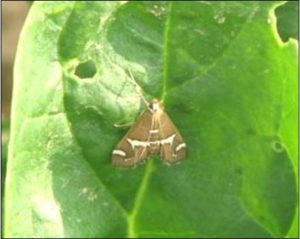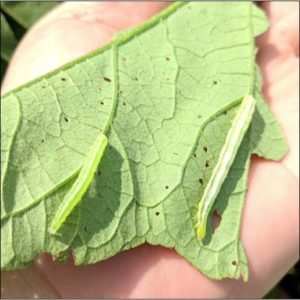There will be no maps for this edition of the IPM Update.
Sweet Corn
State-wide, European corn borer and fall armyworm have declined in the traps. There has been little field activity for either moth.
Corn earworm
Corn earworm populations have declined, but based upon blacklight information, most areas of the state will need to continue on a 3-day silk spray schedule for late season sweet corn. In the pheromone traps of southern NJ, the number of adult males caught has declined indicating a 4-day spray schedule in most locations.
Other vegetable crop pests:
Beet armyworm
Beet armyworm has been generally low in number throughout the summer season. While there was an increase in trap catches for the Hammonton area this past week, it is not likely to be an economic problem.
Pepper weevil
No other field populations have been detected outside of the Hammonton area. This will be the last note for this season regarding pepper weevil.
Hawaiian beet webworm

Hawaiian beet webworm on spinach
We have been picking up small numbers of HBWW in the blacklight traps, especially in southern NJ, in the past couple of weeks. A field was found this week in Cape May County where the HBWW was abundant feeding on pigweed and sugar beets. The primary host of HBWW is pigweed, but amaranth, spinach, beets, sugar beets, and chard are also fed upon. The greenish caterpillars feed on the leaves and produce loose webbing which pulls leaves together. As the larvae mature they become more reddish with longitudinal stripes. Because localized populations can build up large numbers, farmers should check plantings of susceptible crops for this moth. If spraying is necessary, refer to the Mid-Atlantic Commercial Production Recommendations for control options.
Soybean Looper in eggplant
An unusual infestation of soybean looper was found in eggplant this past week in the East Vineland area. The caterpillars resemble cabbage looper but have more distinct white stripes and dark margins on the sides of the head. Soybean looper can feed on a wide range of plants besides soybean, including tomato and pepper. This situation stood out for two reasons: 1) that soybean looper was found in the eggplant, and 2) that any caterpillar infestation was found in eggplant requiring control.

soybean loopers on eggplant

